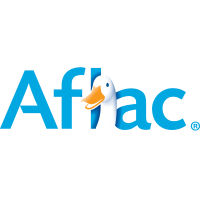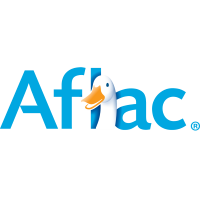
Aflac Inc
NYSE:AFL

Earnings Call Analysis
 Q3-2023 Analysis
Aflac Inc
Q3-2023 Analysis
Aflac Inc
In their recent earnings call, the company presented an intricate picture of their financial health and strategic planning that echoes their resilience and adaptation to market dynamics. The adjusted book value per share rose by 10.3%, and the adjusted Return on Equity (ROE) stood at an impressive 15.6%, markers of solid financial underpinnings. Yet, the narrative is not free of challenges. In Japan, their stronghold, net earned premiums dipped by 2.8% amid paid-up policies, reinsurance transactions, and heightened lapse rates, hinting at the ebb and flow of policyholder behavior. However, the refinement of various metrics like benefit ratios and expense control, paired with investment income growth, paint a hopeful picture of strength and control amid changes.
Stateside, the narrative mixed with a 3.2% increase in net earned premiums and improved persistency conveys effective customer retention strategies. However, a surge in the U.S. expense ratio to 40.6% partially due to software intangibles write-down showcases the bumps on the road to digital transformation and growth initiatives. Real estate investments cast a looming shadow with valuations quoting down between 25% and 60%, but a judicious increase in CECL reserves demonstrates a level-headed approach to market volatility.
A significant subplot of the corporate narrative is the ongoing digital modernization to enhance customer experiences and drive long-term efficiencies. While these investments are yet to mature, there's undeniable optimism that digitization will eventually lower per-policy expenses and streamline processes, shaping a more agile and responsive organization.
Regulatory landscapes loom unpredictably for insurers, yet this company stands poised and ready. With no observed impact in third-quarter sales from regulatory proposals, and the adaptability to operate without certain pretax benefits, it’s clear that they have a well-prepared stance to navigate potential changes in legislation.
Looking ahead, the company anticipates a gradual shift to a normalized pace by 2025 for the paid-up schedules within the Japanese market. This normalization is awaiting the conclusion of a high sales period and is combined with the expectation of continued solid persistency rates. Additionally, the notion of remeasurement gains and assumption changes reflect evolving hospital treatment patterns, with the company adjusting its reserves to mirror the current paradigm.
Growth remains the north star for the company as it aims to drive returns on writing new policies while maintaining a solid capital position, with a Risk-Based Capital (RBC) ratio currently above target. However, they remain pragmatic about adjusting capital through dividends if growth alone can't optimize capital use. Their approach to growth and capital management exudes a disciplined balancing act designed to maximize returns and ensure sustained growth.















 You don't have any saved screeners yet
You don't have any saved screeners yet

Thank you for joining me as I provide a financial update on Aflac Inc's results for the third quarter of 2023.
For the third quarter, adjusted earnings per diluted share increased 27.8% year-over-year to $1.84, with a $0.06 negative impact from FX in the quarter. With this being the third quarter under the new LDTI accounting regime, we evaluate our reserve assumptions for morbidity, persistency and mortality, at least annually, to see if an update is needed. If necessary, these assumptions will be unlocked on a prospective basis as they were in this quarter, leading to remeasurement gains of $205 million.
Variable investment income ran $13 million or $0.02 per share below our long-term return expectations. We also wrote down certain software intangibles in our U.S. segment, impacting our results by $0.04 per share.
Adjusted book value per share, including foreign currency translation gains and losses, increased 10.3%. And the adjusted ROE was 15.6%, a significant spread to our cost of capital.
Overall, we view these results in the quarter as solid.
Starting with our Japan segment. Net earned premium for the quarter declined 2.8%, reflecting the impact of paid-up policies, our January 1 reinsurance transaction and deferred profit liability. Lapses were somewhat elevated but within our expectations. However, if adjusting for all these factors, the earned premium declined an estimated 1.7%.
Japan's total benefit ratio came in at 65.1% for the quarter, down 170 basis points year-over-year. And the third sector benefit ratio was 54.8%, down approximately 460 basis points year-over-year.
We continue to experience favorable actual to expected on our well-priced, large and mature in-force block. We estimate the impact from remeasurement gains to be 260 basis points favorable to the benefit ratio in Q3.
Long-term experience trends as it relates to treatment of cancer and hospitalization continue to be in place, leading to favorable underwriting experience.
Persistency remained solid with a rate of 93.5% but was down 80 basis points year-over-year. With product refreshments, we tend to experience some elevation in lapses as customers update and refresh their coverage, which was the case with the recently refreshed cancer and first sector products.
Our expense ratio in Japan was 19%, down 100 basis points year-over-year, driven primarily by good expense control and, to some extent, by expense allowance from reinsurance transactions and a DAC commission true-up. For the full year, we would expect to end up towards the low end of our expense ratio range of 20% to 22%.
Adjusted net investment income in yen terms was up 7.2% as we experienced higher yields on our U.S. dollar-denominated investments and related favorable FX and a return on our alternatives portfolio, more in line with our long-term return expectations. This was offset by transfer of assets due to reinsurance.
In the quarter, we reduced our FX forwards and increased FX put options notional, leading to lower run rate hedge costs and a more efficient use of our investment risk capital.
The pretax margin for Japan in the quarter was 32.8%, up 350 basis points year-over-year, a very good result for the quarter.
Turning to U.S. results. Net earned premium was up 3.2%. Persistency increased 80 basis points year-over-year to 78.7%. This is a function of poor persistency quarters falling out of the metric and stabilization across numerous product categories, especially group voluntary benefits.
Our total benefit ratio came in lower than expected at 35.9%, a full 890 basis points lower than Q3 2022. We estimate that the remeasurement gains impacted the benefit ratio by 12.1 percentage points in the quarter.
Claims utilization remains subdued. And as we incorporate more recent experience into our reserve models, we have released some reserves.
For the full year, we now estimate our benefit ratio to be materially below our outlook range of 47% to 50%. Excluding remeasurement gains, however, we are tracking well within the 47% to 50% outlook range.
Our expense ratio in the U.S. was 40.6%, up 70 basis points year-over-year. This includes a 190 basis points impact from a software intangibles write-down. Adjusting for this write-down, we are trending in the right direction.
Our growth initiatives, group life and disability, network dental and vision and direct-to-consumer increased our total expense ratio by 330 basis points. We would expect this impact to decrease over time as these businesses grow to scale and improve their profitability.
For the full year, we now expect our expense ratio to come in slightly above our outlook range of 37% to 40%.
Adjusted net investment income in the U.S. was up 13%, mainly driven by higher yields on both our fixed and floating rate portfolios and variable investment income in the quarter more in line with long-term return expectations.
Profitability in the U.S. segment was solid with a pretax margin of 28.8%, driven primarily by the remeasurement gains from unlocking.
As you know, the commercial real estate markets are going through the worst cycle in decades, especially in the office subsector. We're seeing most property values quoted down 25% to 40%, but some distressed situations are driving market values down as much as 60%, far exceeding the 35% to 40% declines of the financial crisis.
Our total commercial real estate watch list remains approximately $1 billion, with around 2/3 of these in active foreclosure proceedings. As a result of these current low valuation marks, we increased our CECL reserves associated with these loans by $34 million this quarter. We also moved 2 properties into real estate owned, which resulted in a $53 million write-down.
We do not believe the current distressed market is indicative of the true intrinsic economic value of the underlying properties currently undergoing a foreclosure process. We continue to believe our ability to take ownership of these quality buildings and manage them through this cycle will allow us to maximize our recoveries.
In our corporate segment, we recorded a pretax loss of $49 million, which is somewhat smaller than a year ago, primarily due to our reinsurance transaction. Adjusted net investment income was $8 million lower than last year due to an increased volume of tax credit investments. Higher rates began to earn in, and amortized hedge income increased. These tax credit investments impacted the corporate net investment income line for U.S. GAAP purposes negatively by $64 million, with an associated credit to the tax line. The net impact to our bottom line was a positive $3.8 million in the quarter. To date, these investments are performing well and in line with expectations.
We are continuing to build out our reinsurance platform, and I'm pleased with the outcome and performance. In Q4, we intend to execute another tranche with similar structure and economics to our first transaction from January this year.
Our capital position remains strong, and we ended the quarter with an SMR above 1,000% in Japan. And our combined RBC, while not finalized, we estimate to be greater than 650%. Unencumbered holding company liquidity stood at $3.3 billion, $1.6 billion above our minimum balance. These are strong capital ratios, which we actively monitor, stress and manage to withstand credit cycles as well as external shocks.
U.S. stat impairments were $4 million and Japan FSA impairments, JPY 2.9 billion or roughly $20 million. This is well within our expectations and with limited impact to both earnings and capital.
Leverage remains at a comfortable 18.8%, just below our leverage corridor of 20% to 25%. The decline in the quarter is primarily driven by the weakening yen. As we hold approximately 2/3 of our debt denominated in yen, our leverage will fluctuate with movements in the yen-dollar rate. This is intentional and part of our enterprise hedging program, protecting the economic value of Aflac Japan in U.S. dollar terms.
We repurchased $700 million of our own stock and paid dividends of $248 million in Q3, offering good relative IRR on these capital deployments. We will continue to be flexible and tactical in how we manage the balance sheet and deploy capital in order to drive strong risk-adjusted ROE with a meaningful spread to our cost of capital.
Thank you for your time and attention. I look forward to discussing our results in further detail on tomorrow's earnings call.